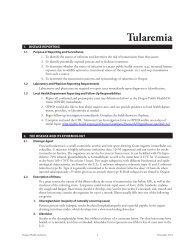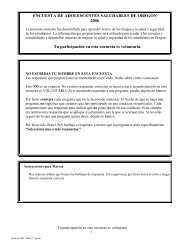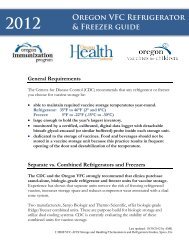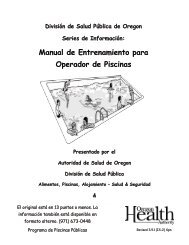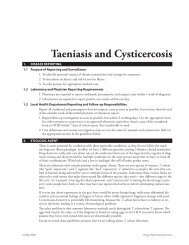Sedimentation and Clarification - Public Health
Sedimentation and Clarification - Public Health
Sedimentation and Clarification - Public Health
Create successful ePaper yourself
Turn your PDF publications into a flip-book with our unique Google optimized e-Paper software.
Optimization of the <strong>Sedimentation</strong> <strong>and</strong> <strong>Clarification</strong> Process<br />
Optimization of the clarification process will minimize solids loading on the filters <strong>and</strong> will<br />
contribute to enhanced filter performance <strong>and</strong> better overall treated water quality.A water system<br />
should consider the following items when evaluating sedimentation basins:<br />
1. Conducting a tracer study in the sedimentation basin. Often, very simple design changes<br />
can be made to improve sedimentation basin performance. For information on tracer<br />
studies, see the LT1ESWTR Disinfection Profiling <strong>and</strong> Benchmarking Technical<br />
Guidance Manual (EPA, 2003).<br />
2. Is sludge collection <strong>and</strong> removal adequate? Inadequate sludge collection <strong>and</strong> removal can<br />
cause particles to become re-suspended in water or upset circulation. Systems should<br />
disrupt the sludge blanket as little as possible. Sludge draw-off rates can affect the sludge<br />
blanket. Sludge draw-off procedures should be checked periodically, making sure sludge<br />
levels are low <strong>and</strong> sludge should be wasted if necessary. Sludge pumping lines should be<br />
inspected routinely to ensure that they are not becoming plugged. These lines should also<br />
be flushed occasionally to prevent the buildup of solids.<br />
3. Do basin inlet <strong>and</strong> outlet conditions prevent the breakup of formed floc particles? Settling<br />
basin inlets are often responsible for creating turbulence that can break up floc.<br />
Improperly designed outlets are also often responsible for the breakup of floc. Finger<br />
launders (small troughs with V–notch weir openings that collect water uniformly over a<br />
large area of a basin) can be used to decrease the chance of floc breakup.<br />
4. Is the floc the correct size <strong>and</strong> density? Poorly formed floc is characterized by small or<br />
loosely held particles that do not settle properly <strong>and</strong> are carried out of the settling basin.<br />
Such floc may be the result of inadequate rapid mixing, improper coagulant dosages, or<br />
improper flocculation. Systems should look to previous steps in the treatment train to<br />
solve this problem.<br />
5. Is the basin subject to short-circuiting? If the basin is not properly designed, water<br />
bypasses the normal flow path through the basin <strong>and</strong> reaches the outlet in less than the<br />
normal detention time. Causes of shortcircuiting may include poor influent baffling or<br />
improperly placed collection troughs. If the influent enters the basin <strong>and</strong> hits a solid<br />
baffle, strong currents may result. A perforated baffle may distribute inlet water without<br />
causing strong currents. Tube or plate settlers may also improve efficiency, especially if<br />
flows have increased beyond original design conditions. The installation of tube settlers<br />
can sometimes double a basin’s original settling capacity.<br />
6. Are basins located outside <strong>and</strong> subject to windy conditions? Wind can create currents in<br />
open basins that can cause short-circuiting or disturb the floc. If wind poses a problem,<br />
installing barriers may reduce the effect <strong>and</strong> keep debris out of the unit.<br />
7. Are basins subject to algal growth? Although primarily a problem in open, outdoor<br />
basins, algae can also grow as a result of window placement around indoor basins. Algae<br />
should be removed regularly to avoid buildup.<br />
8. Is the sludge blanket in SCUs maintained properly? Operators should be able to measure<br />
the sludge depth <strong>and</strong> percent solids to ensure the sludge blanket is within the<br />
manufacturer’s recommendations. A timing device to ensure consistent blanket quality<br />
characteristics should control sludge removal rates <strong>and</strong> schedule.<br />
9. Is the recirculation rate for SCUs within the manufacturer’s recommendations? Various<br />
designs have different recirculation rates <strong>and</strong> flow patterns. Systems should refer to the<br />
manufacturer’s operation manual.




